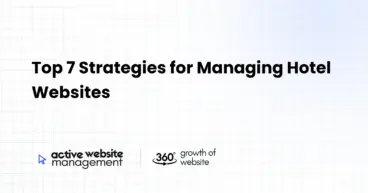January 2, 2025
8 min read
Internal linking is a powerful yet often underutilized SEO technique that plays a vital role in improving your website’s search engine rankings, user experience, and overall site navigation. By optimizing your internal linking structure, you create a network of links that connect your content, making it easier for both users and search engines to navigate through your site. This article will delve into the significance of internal linking, best practices for optimizing your internal linking structure, and how it directly impacts SEO and user experience. We will also explore how Active Website Management can help you maintain a robust internal linking structure for long-term success.
1. What Is Internal Linking?
Internal linking refers to the practice of linking one page of a website to another within the same domain. This can be done through hyperlinks within the content, navigation menus, or even footers. Unlike external links, which connect your site to others, internal links are essential for helping both users and search engines find related content on your website.
When done correctly, internal linking makes it easier for search engines to crawl and index your website’s pages, contributing to better SEO performance. It also enhances user experience by providing pathways to related content, keeping visitors engaged longer on your site.
2. Why Is Internal Linking Important?
Internal linking is important for several reasons, and optimizing it can provide numerous benefits for your website:
- Improves User Experience: By linking to related content, you guide users to discover more relevant articles, products, or pages. This encourages them to explore your site more, which can increase time on site and reduce bounce rates.
- Boosts SEO Rankings: Internal links help search engines understand the structure of your website. When you link to other pages, search engine bots follow these links and discover new content. Properly optimized internal linking helps spread link equity across your site, boosting the SEO value of different pages.
- Establishes Site Hierarchy: Internal linking can define the importance of certain pages by linking to them frequently. Important pages, like product or service pages, should be linked to from other relevant content.
- Distributes Link Equity: Internal links help spread “link juice” (the SEO value passed through links) to other pages on your site. This can help pages with fewer backlinks rank higher in search engine results.
- Improves Crawlability: Search engine bots use links to crawl your site and understand the relationship between different pages. By optimizing your internal links, you make it easier for search engines to index your pages.
3. How Internal Linking Affects SEO
The impact of internal linking on SEO cannot be overstated. Here’s how it directly affects your site’s search engine performance:
- Crawl Efficiency: Search engines use internal links to find and index new pages. If a page on your website is not linked to from other pages, it may not get crawled as efficiently, leading to lower visibility in search results.
- Relevance and Context: Internal links allow you to signal the relevance of a page. By linking from high-authority pages (those with many backlinks or traffic) to other pages, you pass on SEO value and give search engines a clue about the importance of that content.
- Targeted Keyword Optimization: When you use anchor text in your internal links, it provides contextual information to search engines. For example, if you link to a blog post about “eCommerce website security,” using the exact phrase “eCommerce website security” as anchor text reinforces the relevance of the linked page to that keyword.
- Deep Linking: Internal linking can help you rank for long-tail keywords by creating links to deeper pages in your website’s structure. This ensures that even less popular pages get visibility from search engines, thus enhancing their chances of ranking.
- Site Structure: Proper internal linking helps create a solid, logical structure. This makes it easier for both search engines and users to navigate, improving the likelihood of ranking well in search engine results.
Don’t Just Maintain Your Website—
Grow It using Active Website Management! Don't Wait for Growth—Accelerate It with Active Website Management
4. Best Practices for Optimizing Your Internal Linking Structure
Now that we’ve established the importance of internal linking, let’s explore some best practices for optimizing your website’s internal linking structure. Following these strategies will ensure that both search engines and users benefit from your internal links.
4.1 Use Descriptive Anchor Text
Anchor text is the clickable text that appears as a hyperlink. Using descriptive anchor text is crucial for SEO. Rather than using generic terms like “click here,” aim to use relevant keywords that describe the content on the linked page.
For example, instead of:
- Click here to read more about Shopify security.
Use:
- Learn how to secure your Shopify store to prevent data breaches.
This gives both search engines and users clear context about the linked page and improves the chances of ranking for the target keywords.
4.2 Create a Logical Site Hierarchy
Your website’s internal linking should reflect a logical structure, ideally following a hierarchy from general to specific topics. This hierarchy helps both users and search engines understand the relationship between different pages on your site.
For example, you might have a top-level page like “Website Maintenance” which links to more specific pages like:
- “WordPress website maintenance”
- “Shopify website maintenance”
- “SEO for website maintenance”
Each of these pages should also internally link to related content to further strengthen the connection between them.
4.3 Link to High-Quality Content
Link to the best and most valuable content on your site. This could include pages that drive the most traffic, convert visitors into leads, or provide in-depth knowledge. The more internal links point to a page, the more likely it is to be seen as an authoritative page by search engines.
4.4 Prioritize Important Pages
Ensure that your internal links prioritize important pages that align with your business objectives. For example, if you’re running an e-commerce site, your product or service pages should be linked frequently from your blog posts, category pages, and other key pages to improve their visibility.
4.5 Avoid Overuse of Links
While it’s tempting to add as many internal links as possible, excessive linking can lead to a poor user experience and even penalization from search engines. Aim for a balanced number of internal links that provide real value to your users.
As a rule of thumb, use internal links where they genuinely add context and help users navigate to related content. Ensure that your anchor text is relevant and useful.
4.6 Maintain URL Depth
Try to keep important pages within a few clicks of your homepage. If your content is buried deep within your site, it can be harder for both search engines and users to find. Ensure that your most important pages are easily accessible through internal links.
Several tools can help you monitor and optimize your internal linking strategy:
- Google Search Console: Use this tool to identify which pages on your site have the most internal links and which ones need more attention.
- Screaming Frog SEO Spider: This tool allows you to crawl your website and analyze internal links, broken links, and site structure.
- Ahrefs: Ahrefs can help you analyze internal link structure, identify opportunities, and track the performance of your internal links over time.
- Yoast SEO (for WordPress users): If you’re using WordPress, Yoast SEO can help you manage internal links and suggest opportunities for improving your linking structure.
6. How Active Website Management Can Help
Active Website Management (AWM) offers a comprehensive solution to ensure that your website’s internal linking structure is always optimized for SEO and user experience. With AWM, you can benefit from:
- Regular Content Updates: We keep your content fresh and interlinked, ensuring that each page is connected to relevant, high-performing content on your site.
- SEO and Performance Optimization: Our team can help optimize your internal linking structure, ensuring that search engines crawl and index your pages efficiently.
- Ongoing Strategy: We work with you to create a personalized SEO strategy that includes the best practices for internal linking, ensuring continuous growth and improvement.
To learn more about how we can help your website grow, check out our plans and pricing.
Don't Wait for Growth—Accelerate It with
Active Website Management Don't Wait for Growth—Accelerate It with Active Website Management
7. Conclusion
Optimizing your website’s internal linking structure is an essential part of any successful SEO strategy. By following best practices such as using descriptive anchor text, creating a logical site hierarchy, and prioritizing important pages, you can significantly improve your website’s SEO performance and user experience. Regularly optimizing and reviewing your internal linking strategy will ensure that your website continues to grow and rank higher in search engine results.
If you want to take the guesswork out of optimizing your website’s internal linking structure, consider partnering with Active Website Management. We’ll handle the technical aspects of internal linking, SEO optimization, and content updates, so you can focus on growing your business.





